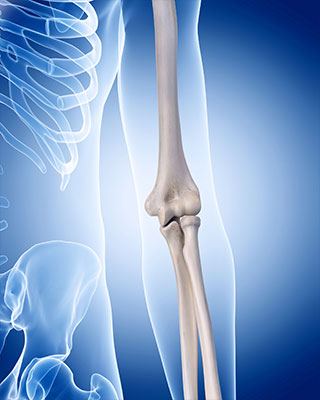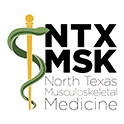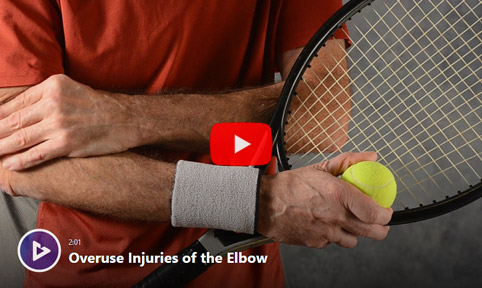Elbow Conditions
 The elbow is formed at the articulation of three separate bones and is actually composed of 3 joints. The primary joint formed by the humerus and ulna allows only for flexion and extension. The third is a pivot joint formed by the radius and ulna which allows the rotating motion of the lower arm.These joints are supported by ligaments that connect bones to other bones.
The elbow is formed at the articulation of three separate bones and is actually composed of 3 joints. The primary joint formed by the humerus and ulna allows only for flexion and extension. The third is a pivot joint formed by the radius and ulna which allows the rotating motion of the lower arm.These joints are supported by ligaments that connect bones to other bones.
Tendons are bands of connective tissue that connect muscles to the bones. This tissue helps to support the elbow, but tendons are often a site of pain and inflammation. The most common injury to the elbow is from repetitive motion that causes the tendons to become damaged from overuse.
Treatment Options
Because ligaments and tendons have poor blood supply, they tend to heal slowly and generally incompletely. This often leads to chronic conditions and arthritis. Bone Marrow Aspirate Concentrate, commonly know as Stem Cell Therapy or PRP Injections, helps to accelerate healing and ensure a more complete recovery. Learn more about tendon healing.
Benefits of Regenerative Medicine
Natural Healing:
Regenerative Medicine treatments harness the body's innate healing mechanisms, promoting long-term recovery rather than temporary symptom relief.
Enhanced Tissue Repair:
Regenerative Medicine aims to repair and regenerate damaged tissues, potentially restoring function and reducing the need for more invasive treatments.
Reduced Risk of Side Effects:
Unlike corticosteroids, regenerative therapies generally have fewer and less severe side effects, as they use natural substances from the patient's own body.
What Are Regenerative Medicine Procedures?
Regenerative medicine offers a transformative approach to treating musculoskeletal conditions by harnessing the body's natural healing capabilities to give your body a needed boost to help heal naturally, only faster and better. Bone Marrow Aspirate Concentrate (aka Stem Cell therapy) and Platelet Rich Plasma Injections offer a unique alternative to traditional medical interventions, going beyond symptom management to address the root causes of musculoskeletal conditions. For patients struggling with orthopedic injuries, joint arthritis, or other degenerative conditions that cause pain, stem cell therapy offers a non-surgical option that uses the body’s natural healing power to improve function and reduce pain.
- Platelet-Rich Plasma (PRP) Therapy: PRP therapy involves extracting a small amount of the patient's blood, processing it to concentrate the platelets, and injecting this platelet-rich plasma into the injured area. PRP is rich in growth factors that promote tissue repair and regeneration.
- BMAC, (Stem Cell Therapy): BMAC uses the patient's own stem cells, typically harvested from bone marrow or adipose tissue, to promote healing. These stem cells can differentiate into various types of cells needed for repair, such as cartilage or tendon cells.
- Prolotherapy: The procedure involves injecting a solution, often containing dextrose, into the damaged area. This solution irritates the tissue, triggering the body's natural healing response and promoting the repair of ligaments and tendons.
Regenerative procedures are designed to help reduce knee pain and improve function with precise
highly specific image-guided medical procedures.
If you are an athlete, or if you work with your arms and hands, your elbows may be at risk for an overuse injury. This is an injury caused by repetitive motions. This type of injury can be a problem for people who play sports such as tennis or baseball. Children also have a higher risk, because their bones are still growing.
To determine if Regenerative Orthopedics will be helpful for you, please tell us about your condition.
Common Applications

-
Overuse injuries. Overuse injuries involve tendons that become strained from excess use, such as Golfer's Elbow and Tennis Elbow. Inflammation of the epicondyle of the ulnar caused by micro tears from strain is common with throwing injuries in young athletes.
-
Olecranon bursitis. Bursitis is an inflammation of small sacs of fluid (bursae) that help joints move smoothly. The causes of elbow bursitis may include trauma or a hard blow, excessive leaning on the elbow, or conditions such as gout and rheumatoid arthritis.
-
Biceps tendinitis. When the main tendon that attaches the biceps to the shoulder becomes inflamed, the front and top of the shoulder will ache. The sheath covering the tendon gradually starts to thicken. The tendon may tear, commonly called a slap tear, leading to a bulge in the upper arm. Biceps tendinitis can occur with sports and job-related activities that involve repetitive overhead arm movements, or simply with age.
-
Ulna and radial collateral ligament sprains. These ligaments are the main source of stability for the elbow. Damage to these ligaments from injury or repetitive use will cause pain along the inside of the elbow. Read more about tendon and ligament injuries.
Biceps Tendinitis
This condition occurs when a tendon in your elbow, the distal biceps tendon, becomes inflamed or irritated. The biceps tendon connects the biceps muscle of your upper arm to the radius bone at the elbow.
Lateral Epicondylitis (Tennis Elbow)
Commonly called tennis elbow, this condition is an inflammation of the tendons that connect the muscles of the forearm to the elbow. The pain is primarily felt at the lateral epicondyle, the bony bump on the outer side of the elbow.
Understanding the Risks of High-Dose Corticosteroid Injections
Management of pain and inflammation is a critical aspect of care for musculoskeletal conditions. High-dose corticosteroid injections have been standard treatment for conditions such as arthritis, tendonitis, and bursitis. However, while these injections can provide rapid relief, they are not without significant risks.
Corticosteroid injections work by reducing inflammation, thereby alleviating pain. However, the use of high-dose corticosteroids comes with several potential adverse effects:
- Joint and Tissue Damage: Repeated corticosteroid injections can lead to the weakening of tendons, cartilage, and bone. This can result in joint instability and an increased risk of tendon ruptures.
- Osteoporosis: High doses of corticosteroids can accelerate bone loss, increasing the risk of fractures and osteoporosis.
- Infection Risk: Corticosteroid Injections can suppress the immune system, potentially leading to infections such as septic arthritis.
- Endocrine Disruption: Corticosteroids can interfere with the normal function of the adrenal glands, potentially causing hormonal imbalances and conditions such as Cushing's syndrome.
- Short-Term Relief: While corticosteroids can provide rapid pain relief, this effect is often temporary, necessitating repeated injections and increasing the risk of cumulative damage.
We Can Help
To learn more about what we can do to help with your elbow condition, call our office at 817-416-0970. We will thoroughly diagnose your condition and present you with treatment options. From there we will guide you along your road to recovery.

